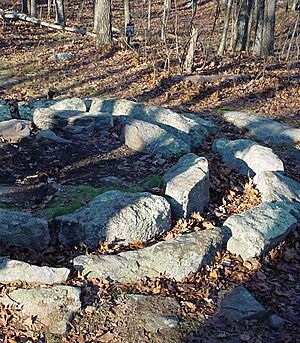Gungywamp facts for kids
Gungywamp is an archaeological site in Groton, Connecticut, United States. It holds many old objects and structures. These include things from Native American and early American colonial times. Some items found here are very old, dating back over 2,000 years!
One special part of Gungywamp is a stone room. It lines up with the sun during the equinoxes (when day and night are equal). There are also stone circles and other mysterious stone structures.
Contents
What is Gungywamp?
The Gungywamp site covers about 100 acres. It has many different features from various time periods. You can find remains of old houses here. There are also places where people might have processed cloth or iron.
Stone Chambers and Root Cellars
The site has several stone rooms, often called "stone chambers." Many experts believe these were used as root cellars. Root cellars are like underground pantries. People used them to store food, keeping it cool in summer and warm in winter. Two of these stone chambers are still fully intact. Nicholas Bellantoni, a state archaeologist, noted that Gungywamp has "so many of them," which makes it special.
The Calendar Chamber
One of these stone rooms is known as the "calendar chamber." It has a cool feature related to astronomy. During the equinoxes, the sun shines through a hole in the west wall. This light hits a lighter stone on the opposite side. It then lights up a smaller, beehive-shaped room inside. This shows how people might have tracked the seasons long ago.
The Stone Circles
A bit away from the main structures, there is a large stone circle. It's actually two circles, one inside the other, and is over ten feet wide. The outer ring has twelve curved stones.
Archaeologists have different ideas about what this stone circle was for. Some think it was a mill. The archaeologist Ken Feder believes it was a bark mill. This type of mill was used to crush tree bark to get tannin. Tannin was important for making leather. Animals would walk in a circle, pulling a mill wheel between the two stone rings. Other researchers think it might have been built by Native Americans.
Etched Stones
Even further away, there is a line of low standing stones. They face north and south. One of these stones has a picture etched into it. It shows a bird with its wings spread out.
What Does "Gungywamp" Mean?
The exact meaning of the name "Gungywamp" is not fully known. Researchers have linked the name to old languages like Gaelic, Mohegan, Pequot, and Algonquin. It could mean many things, such as "church of the people," "place of ledges," "swampy place," or even "all powerful" and "white."
Artifacts Found at Gungywamp
Many interesting objects, called artifacts, have been found at Gungywamp.
Native American Artifacts
Native American artifacts include arrowheads, stone flakes (small pieces of stone left over from making tools), and pieces of pottery.
Colonial Artifacts
From the colonial period, people have found pottery, china, buttons, coins, pieces of glass from bottles and windows, eating tools, tobacco pipes, bricks, and animal bones. It's interesting that no artifacts have been found inside the stone chambers themselves. This makes it harder to know their exact purpose.
Mysteries of the Stone Chambers
The exact purpose and age of the stone chambers are still a bit of a mystery.
Possible Uses
The strongest idea is that they were root cellars built by early European settlers. Other ideas suggest they might have been built by slaves during colonial times. Or, they could have been built by Native American tribes like the Pequot or Mohegan. Some even suggest the site could be part of a "ceremonial stone landscape." These are special places described by Native American groups like the United South and Eastern Tribes.
The Irish Connection Theory
Gungywamp is well-known because of a theory from the 1960s. This idea suggests that the stone chambers look like structures found in Medieval Ireland. Some people believe this means that Irish monks, called Culdees, might have visited America before Christopher Columbus. This theory suggests there was European settlement in the Americas before Columbus. However, this is just a theory and not proven.
The North Complex Area
This part of the site does not have stone chambers. But it does have other interesting structures.
Old Lodge Remains
One feature is a low, rectangular mound of earth. When archaeologists dug here, they found stumps of posts on three sides. This suggests it was once a Native American lodge, a type of house made from young trees. Two old fireplaces were found near this lodge.
Cairns and Standing Stones
Nearby, there is a long pile of stones, called a cairn. It's shaped like a boat, narrow at the ends and wide in the middle. On top of this cairn were three short standing stones. In the same area, there are nineteen more cairns built on the ground. More cairns were built on top of large rocks scattered around. There were also three other standing stones in this area.
Recent News
In 2018, a large part of the Gungywamp land (270 acres) was given to the State of Connecticut. Discussions are now happening about how to let people visit the site legally. This is important to make sure the old archaeological areas are protected.


